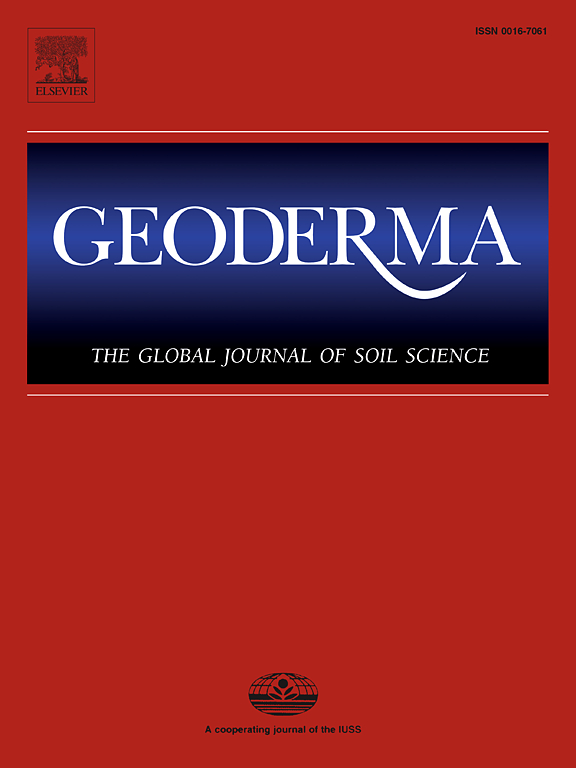Consequences of subtropical land-use intensity for the abundance and diversity of earthworm ecological categories
IF 5.6
1区 农林科学
Q1 SOIL SCIENCE
引用次数: 0
Abstract
Understanding how soil biodiversity, especially of macrofauna like earthworms, responds to land-use intensity is crucial for developing sustainable land-use strategies. This work is a two-year field investigation of earthworm community responses to increasing land-use intensity, from undisturbed fallow land to actively cultivated agricultural lands (including fallow land, tea plantation, orange plantation, camphora plantation, synthetic fertilizer-amended cropland, compost-amended cropland, and vermicompost-amended cropland) in a subtropical region. Earthworm abundance and diversity increased with land-use intensity, likely due to the compensatory effects of organic amendments, which improve the habitat and resource availability, thereby alleviating the potential negative impacts of tillage and harvesting. Notably, earthworm abundance was higher in cropland (70 ind. m−2) than in other land-use types, such as fallow (4 ind. m−2) and plantation (22 ind. m−2). Greater earthworm abundance was associated with higher soil pH and more food resources, as indicated by high microbial biomass carbon (C), the humification index, and the particulate organic C fraction. Anecic and endogeic earthworms increased more than epigeic earthworms from fallow lands to plantations and croplands, reflecting their ecological adaptability to the soil conditions in managed lands with higher land-use intensity. This suggests that soil ecological restoration practices may enhance the role of earthworms related to soil structure dynamics and carbon sequestration. Our study provides empirical evidence that soil macrofauna have ecological adaptations to cope with agricultural intensification across landscapes.
亚热带土地利用强度对蚯蚓生态类群丰度和多样性的影响
了解土壤生物多样性,特别是蚯蚓等大型动物的生物多样性如何对土地利用强度做出反应,对于制定可持续的土地利用战略至关重要。本研究是一项为期两年的野外调查,研究了亚热带地区蚯蚓群落对土地利用强度增加的响应,从未受干扰的休耕地到积极耕作的农业用地(包括休耕地、茶园、柑橘园、樟树园、合成肥料改良地、堆肥改良地和蚯蚓堆肥改良地)。蚯蚓的丰度和多样性随着土地利用强度的增加而增加,这可能是由于有机改良的补偿作用,它改善了生境和资源的可利用性,从而减轻了耕作和收获的潜在负面影响。值得注意的是,蚯蚓丰度在农田(70 ind. m - 2)高于其他土地利用类型,如休耕(4 ind. m - 2)和人工林(22 ind. m - 2)。蚯蚓丰度越高,土壤pH值越高,食物资源越多,微生物生物量碳(C)、腐殖化指数和颗粒有机C分数越高。从休耕地到人工林和农田,内生蚯蚓的数量增加高于表观蚯蚓,反映了它们对土地利用强度较高的管理土地土壤条件的生态适应性。这表明土壤生态修复措施可以增强蚯蚓在土壤结构动态和固碳方面的作用。我们的研究提供了经验证据,表明土壤大型动物具有生态适应性,以应对景观上的农业集约化。
本文章由计算机程序翻译,如有差异,请以英文原文为准。
求助全文
约1分钟内获得全文
求助全文
来源期刊

Geoderma
农林科学-土壤科学
CiteScore
11.80
自引率
6.60%
发文量
597
审稿时长
58 days
期刊介绍:
Geoderma - the global journal of soil science - welcomes authors, readers and soil research from all parts of the world, encourages worldwide soil studies, and embraces all aspects of soil science and its associated pedagogy. The journal particularly welcomes interdisciplinary work focusing on dynamic soil processes and functions across space and time.
 求助内容:
求助内容: 应助结果提醒方式:
应助结果提醒方式:


